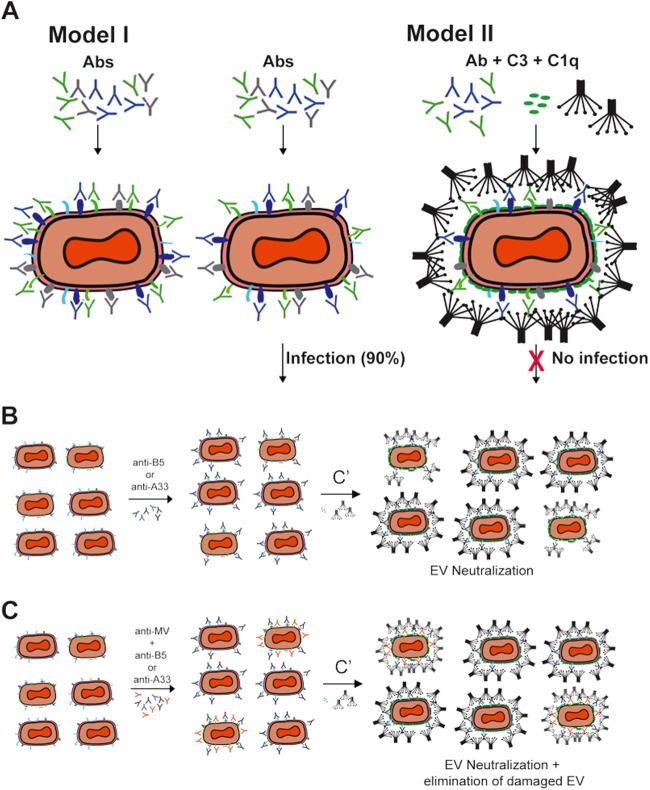Fig 8.
Mechanism of EV neutralization. (A) Models of VACV EV neutralization. Schematic diagrams of potential virion neutralization pathways. B5, A33, and A56 are drawn in green, blue, and gray, respectively. An unknown hypothetical EV surface antigen is drawn in cyan. Abs in model I are anti-B5, anti-A33, and anti-A56. Abs in model II are anti-B5 and anti-A33. Complement (C′) components include C1q and C3. Model I is the basic occupancy model. MAbs against three exposed EV antigens, B5, A33, and A56, could completely coat the functional antigens on the virion surface and subsequently neutralize the virus. This model failed. Direct occupancy of B5, A33, and A56 with Abs is insufficient to block infection of targets cells. VACV EV escape of neutralization by anti-B5, anti-A33, and anti-A56 Ab binding may be due to limited abundance of each antigen on the surface of EV, resulting in a lack of blocking of an unknown EV surface protein still able to facilitate infection. Alternatively, the infectious component of the virion surface is lipid and there is insufficient viral protein on the surface for the anti-VACV Abs to cover the surface, leaving the fusogenic membrane accessible. Model II shows complement-assisted single-specificity or two-specificity anti-EV MAbs coating VACV EV via opsonization. Antibody-mediated protection against VACV EV is dependent on activation of complement C1q via the Fc domain of the immunoglobulin and covalent attachment of C3 to the lipid outer membrane of the virus. (B and C) The presence of anti-MV Abs in EV stock is not necessary for EV neutralization. Schematic diagrams of potential virion neutralization pathways. EV and damaged EV (EV/MV) particles are presented in EV stock. B5 and A33 are drawn in cyan and gray, respectively. L1 or H3, as an MV protein, is drawn in green. The Abs were anti-B5 and anti-A33. Complement (C′) components included C1q and C3. (B) MAbs against one or two exposed EV antigens, B5 and/or A33, could completely coat the functional antigens on EV and EV/MV and subsequently neutralize EV in the presence of complement components C1q and C3. (C) MAbs against one or two exposed EV antigens, B5 and/or A33, could completely coat the specific antigens on EV and EV/MV, and anti-MV Abs coat a specific antigen on the surface of EV/MV particles. Subsequently, the addition of the complement enhances the neutralization of EV and EV/MV particles.

